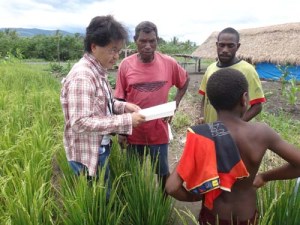Brown Plant Hopper (BPH) is an important insect pest of rice which farmers will have to live with in PNG but there are control methods, other than insecticides, which farmers can use to reduce the pest’s intensity, a Japanese rice expert told a seminar in Lae last week.
Dr Masaya Matsumura of the Japan International Cooporation Agency (JICA), who conducted field surveys on the identification, occurrence and control of the pest in Morobe and Madang provinces early this month with the support of local partners, said BPH is endemic in PNG. He said BHP is one of the three major rice planthoppers common in Asia-Pacific Regions – the others are whitebacked planthopper and small brown planthopper.The JICA team, together with scientists from the Department of Agriculture and Livestock (DAL), ROC Taiwan and the National Agricultural Research Institute (NARI) visited eight rice fields of smallholders – three in Morobe and five in Madang.
During the survey, the team observed that BPH was common in all the eight sites with high density in farms that sprayed insecticides and chemical fertilizers, especially in the Markham area. At Kaiapit, the BPH impact, hopperburn, was observed on the TCS10 rice variety during flowering stage and early harvesting was recommended for farmers.
Dr Matsuruma said because farmers were applying insecticides, BPH density was partly high. He said the survey team observed that the TCS 10 rice variety is highly susceptible to BPH.
Miriam John of DAL said TCS-10, NARI released varieties (NARI 9 and 15) and local varieties (Finch white and brown) are susceptible to BPH except NARI 1. Ms John said Madang farmers didn’t use insecticides or fertilizers but rather practice shifting cultivation and crop rotation which helped reduce BPH infestations.TCS10 was a common variety cultivated by Kaiapit farmers while local varieties (Finch Brown and White) were common in Madang.
Dr Masaya Matsumura made the following suggestions for BPH control in PNG:
1. Choosing resistant or tolerant rice varieties
Once BPH occurs in high density, no other option is available to control BPH except insecticide spray or early harvesting. So, it is important to avoid to crop highly susceptible rice varieties.
2. Synchronized cropping
Transplant rice at the same time. If your fields have various stages of rice, BPH can move from one field to another.
3. Crop rotation
Crop rotation is effective to reduce population densities of BPH because the host plant of BPH is only rice.
4. Monitor population density of BPH
It is important to monitor the population density of rice, especially on TSC10 which is highly susceptible.
5. Avoid using insecticides and chemical fertilizers
Insecticides destroy natural enemies and ecosystem of rice fields. Fertilizers increase not only yield but also BPH density. Therefore it is advisable to avoid both.
The seminar was delivered at NARI in Bubia following the field trips and was attended by staff of DAL, NARI, ROC Taiwan and Bris Kanda Inc.
The team also observed symptoms of Rice Ragged Stunt Virus transmitted by BPH on the TCS10 variety in another farmer’s field in the Markham Valley.
Anna Kawi of NARI, who was involved in the survey, said the exercise enhanced capacity building of local participants in insect pest identification and increased knowledge on BPH’s biology, damage and taxonomic characteristics. She said they also acquired skills in recording microscopic images for reporting purposes and monitoring/ sampling techniques for BPH during outbreaks.
Ms John said BPH has only one host plant, rice, and “that can be very destructive”.


